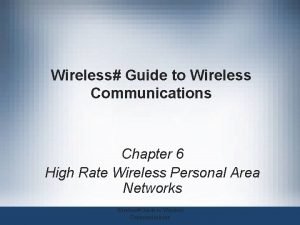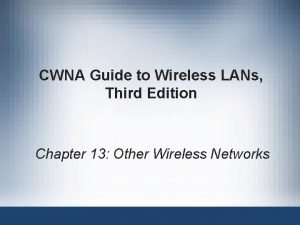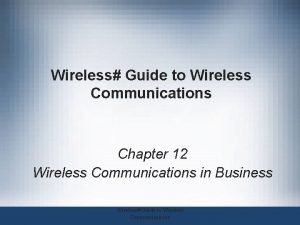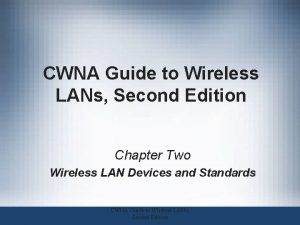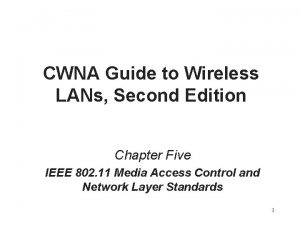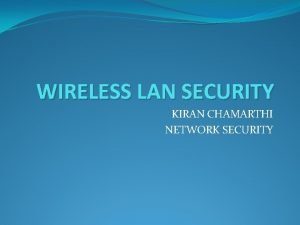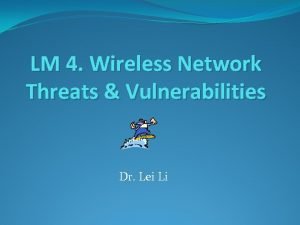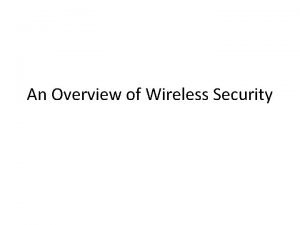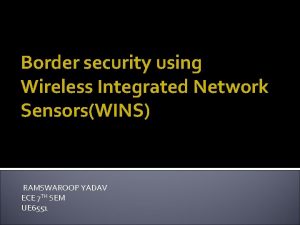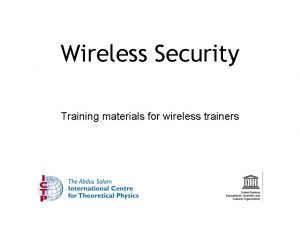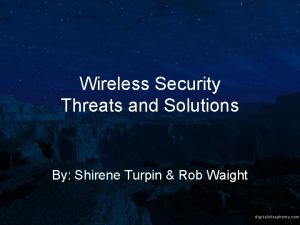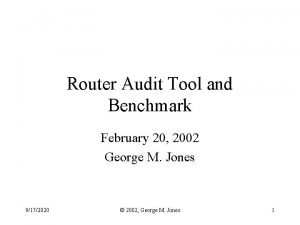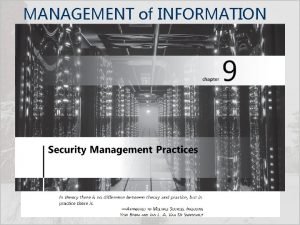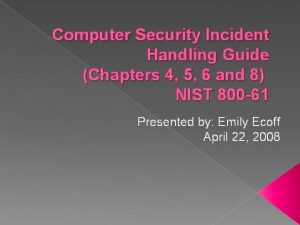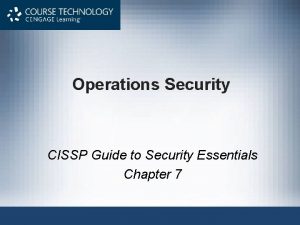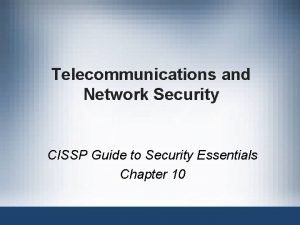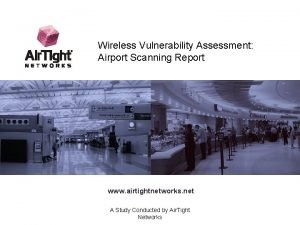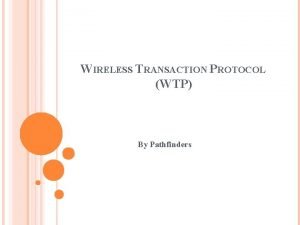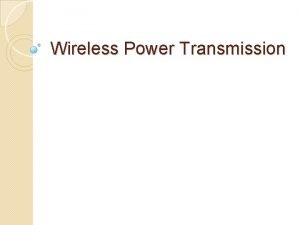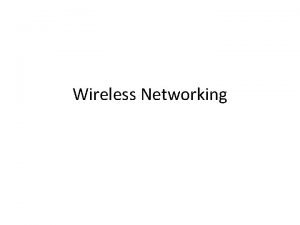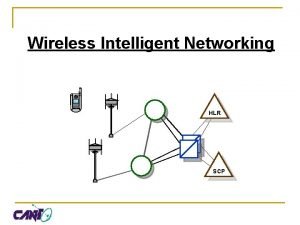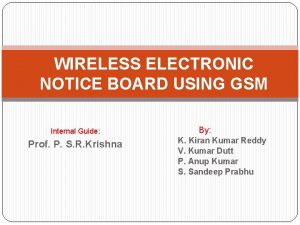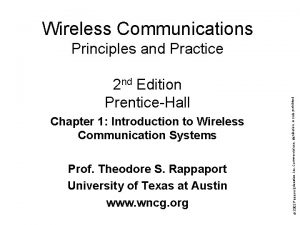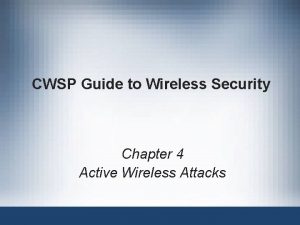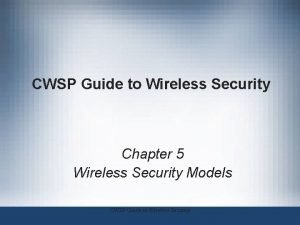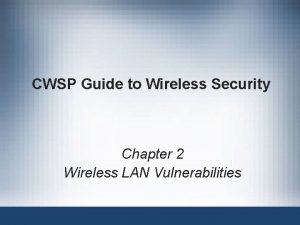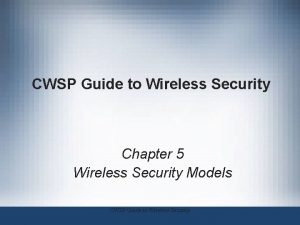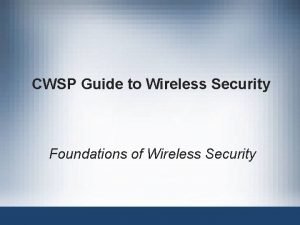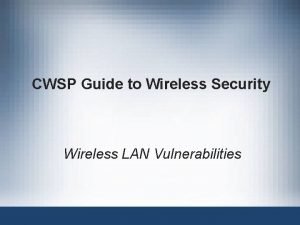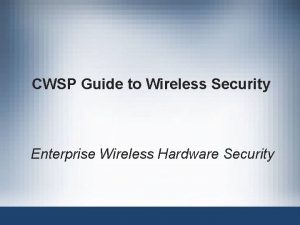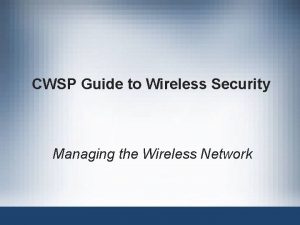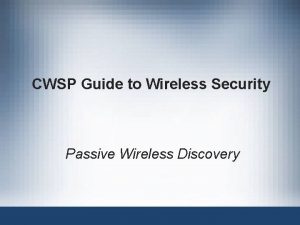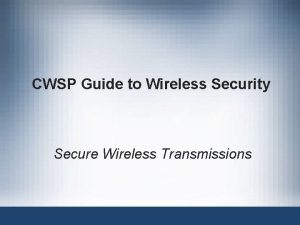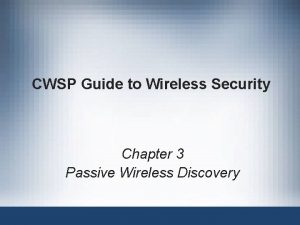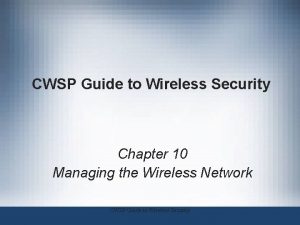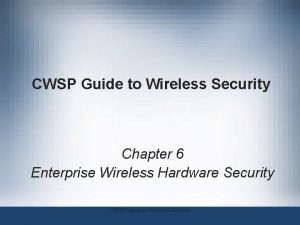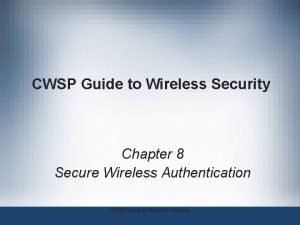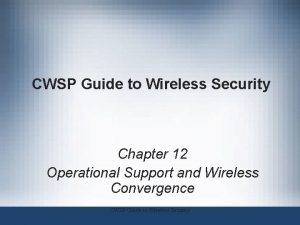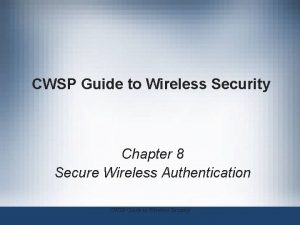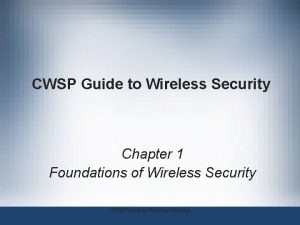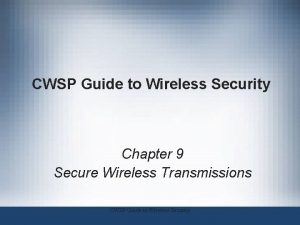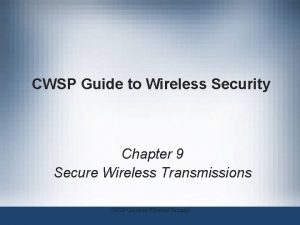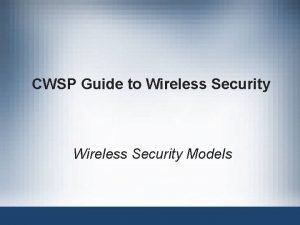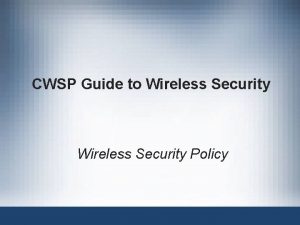CWSP Guide to Wireless Security Chapter 4 Active










































- Slides: 42

CWSP Guide to Wireless Security Chapter 4 Active Wireless Attacks

Objectives • Describe the basic vulnerabilities of a WLAN • Tell how malware and spyware can infect wireless networks • List the vulnerabilities involved with implementing unsecured wireless LANs • Explain the different types of wireless infrastructure attacks CWSP Guide to Wireless Security 2

Security Vulnerabilities • Security vulnerability – Weakness or flaw in an information system – Could be exploited to cause harm – Describes the points of risk regarding the penetration of a security defense • Categories – Basic vulnerabilities – Vulnerabilities when using a public-access WLAN – Vulnerabilities associated with implementing an unsecured wireless network CWSP Guide to Wireless Security 3

Basic Vulnerabilities • Default passwords – Authentication • Users must prove that they are who they claim to be – Based on what they have, know, or are – Password • Secret combination of letters and numbers • Validates or authenticates a user by what she knows • Used with user names to log on to a computer – APs are protected by manufacturers with default passwords CWSP Guide to Wireless Security 4

Basic Vulnerabilities (continued) CWSP Guide to Wireless Security 5

Basic Vulnerabilities (continued) • Weak passwords – Password paradox • Passwords should never be written down, but instead must be committed to memory • Passwords must be of a sufficient length and complexity – Difficult to memorize these types of passwords – Most users today have an average of 20 passwords • Impossible to remember all of them CWSP Guide to Wireless Security 6

Basic Vulnerabilities (continued) • Weak passwords (continued) – Characteristics of weak passwords • • • A common word used as a password Not changing passwords unless forced to do so Passwords that are short Personal information in a password Using the same password for all accounts Writing the password down – Password guessing attacks • Brute force • Dictionary CWSP Guide to Wireless Security 7

Basic Vulnerabilities (continued) • Weak passwords (continued) – Minimum criteria for creating good passwords • Password must be at least eight characters long • Password contains characters from at least three of the following five categories: – – – English uppercase characters (A–Z) English lowercase characters (a–z) Base 10 digits (0– 9) Non-alphanumeric (For example: !, $, #, or %) Extended ASCII characters • Password does not contain three or more characters from the user’s account name CWSP Guide to Wireless Security 8

Basic Vulnerabilities (continued) • Weak passwords (continued) – Additional settings • • Enforce password history Maximum password age Minimum password length CWSP Guide to Wireless Security 9

Basic Vulnerabilities (continued) CWSP Guide to Wireless Security 10

Basic Vulnerabilities (continued) • SNMP community strings – SNMP agents are protected with a password known as a community string – Types of community strings • Read-only string allows information from the agent to be viewed • Read-write string allows settings to be changed – Default SNMP community strings for read-only and read-write were public and private – Administrators used weak strings – Community strings are transmitted in cleartext CWSP Guide to Wireless Security 11

Basic Vulnerabilities (continued) • Improper configuration – Can often result in easy access to a system – Universal Plug and Play (UPn. P) • Allows devices on a network to discover other devices and determine how to work with them • Vulnerabilities – Can enable an attacker to gain complete control over an affected device – Can enable an attacker to prevent an affected system from performing its intended service CWSP Guide to Wireless Security 12

Basic Vulnerabilities (continued) CWSP Guide to Wireless Security 13

Basic Vulnerabilities (continued) • Improper configuration (continued) – Remote access • Allows for the wireless gateway to be configured remotely over the Internet • Allows an attacker to attempt to break into the wireless gateway or access point – Wireless gateway will permit an unlimited number of attempts to break the password CWSP Guide to Wireless Security 14

Basic Vulnerabilities (continued) CWSP Guide to Wireless Security 15

Vulnerabilities Associated with Using Public WLANs • Malware – Computer programs designed to break into and create havoc on portable or desktop computers – Most common types of malware viruses, worms, and logic bombs • Virus – Program that secretly attaches itself to another document or program • Executes when that document or program is opened – One new virus is written and released every hour CWSP Guide to Wireless Security 16

Vulnerabilities Associated with Using Public WLANs (continued) • Virus (continued) – Actions performed by viruses • Cause a computer to repeatedly crash • Erase files from a hard drive • Install hidden programs, such as stolen (“pirated”) software, which is then secretly distributed or even sold from the computer • Make multiple copies of itself and consume all of the free space in a hard drive • Reduce security settings and allow intruders to remotely access the computer • Reformat the hard disk drive CWSP Guide to Wireless Security 17

Vulnerabilities Associated with Using Public WLANs (continued) CWSP Guide to Wireless Security 18

Vulnerabilities Associated with Using Public WLANs (continued) • Virus (continued) – Symptoms • • • A program suddenly disappears from the computer New icons appear on the screen New programs do not install properly Out-of-memory error messages appear Programs stop responding The computer sometimes starts normally, but at other times it stops responding before it finishes loading • Unusual dialog boxes or message boxes appear • Sounds or music play from the speakers unexpectedly CWSP Guide to Wireless Security 19

Vulnerabilities Associated with Using Public WLANs (continued) • Virus (continued) – Symptoms (continued) • • Computer runs very slowly and takes a long time to start There is a significant amount of modem activity The computer restarts unexpectedly Error messages appear listing “critical system files” that are missing, and the operating system refuses to load • Worms – Can travel by themselves – Do not always require action by the computer user to begin their execution CWSP Guide to Wireless Security 20

Vulnerabilities Associated with Using Public WLANs (continued) • Logic bomb – Lies dormant until triggered by a specific logical event – Once triggered, the program can perform various malicious activities – Extremely difficult to detect before they are triggered – Often embedded in large computer programs • Spyware – Software that violates a user’s personal security – Impairs control over the use of system resources CWSP Guide to Wireless Security 21

Vulnerabilities Associated with Using Public WLANs (continued) • Spyware (continued) – Functions performed • Advertising • Collecting personal information • Changing computer configurations – Tool attackers employ spyware to gather personal information about users – Identity theft • Occurs when an individual uses the personal information of someone else CWSP Guide to Wireless Security 22

Vulnerabilities Associated with Using Public WLANs (continued) • Spyware (continued) – Adware delivers advertising content • In a manner or context that is unexpected and unwanted by the user – Adware can also be a security risk • Adware programs perform a tracking function CWSP Guide to Wireless Security 23

Vulnerabilities Associated with Implemented Unsecured WLANs • Information theft – Attacker can gain access to any folder set with file sharing enabled • This would include sensitive documents on a file server • Repository for illegal content – Attacker can set up storage space on a file server • Or a home computer – Attacker can also set up a Web site • Spam site – Spam: unsolicited e-mail CWSP Guide to Wireless Security 24

Vulnerabilities Associated with Implemented Unsecured WLANs (continued) • Spam site (continued) – Approximately 50% of e-mail messages are spam – Spam also reduces work productivity – Spammers often build their own lists of e-mail addresses • Using special software that rapidly generates millions of random e-mail addresses from well-known ISPs – Spammers often swap or buy lists of valid e-mail addresses from other spammers – Spam is a lucrative business – Spam may also be dangerous CWSP Guide to Wireless Security 25

Vulnerabilities Associated with Implemented Unsecured WLANs (continued) CWSP Guide to Wireless Security 26

Vulnerabilities Associated with Implemented Unsecured WLANs (continued) CWSP Guide to Wireless Security 27

Wireless Infrastructure Attacks • Attacks include: – Direct attacks – Denial-of-service attacks CWSP Guide to Wireless Security 28

Direct Attacks Through Rogue Access Points • Rogue access point – AP installed by an employee • Without the approval or supervision of the IT staff – Can provide open access to an attacker • Circumventing the security protections of the company’s network – A rogue access point is behind the firewall • Peer-to-peer attack – Attacker’s wireless device attacks a similar device CWSP Guide to Wireless Security 29

Direct Attacks Through Rogue Access Points (continued) CWSP Guide to Wireless Security 30

Denial-of-Service Attack (Do. S) • Designed to prevent a device from performing its intended function • Do. S attacks are common against wired network servers • SYN flood attack – Client sends server a request called a SYN – Server responds to the client with an ACK • And waits for a reply – Attacker never replies • Server runs out of resources and can no longer function CWSP Guide to Wireless Security 31

Denial-of-Service Attack (Do. S) (continued) CWSP Guide to Wireless Security 32

Denial-of-Service Attack (Do. S) (continued) • Wireless Do. S attacks – Deny wireless devices access to the access point – Categories • Physical layer attacks • MAC layer attacks • Physical layer attacks – Flood the spectrum with radiomagnetic interference • To prevent a device from communicating with the AP CWSP Guide to Wireless Security 33

Denial-of-Service Attack (Do. S) (continued) CWSP Guide to Wireless Security 34

Denial-of-Service Attack (Do. S) (continued) • Physical layer attacks (continued) – Generally rare because sophisticated and expensive equipment is necessary – It is possible to identify the location of the transmitter – Other devices that use the ISM band • • Cordless telephones Microwave ovens Baby monitors Bluetooth personal area network devices CWSP Guide to Wireless Security 35

Denial-of-Service Attack (Do. S) (continued) • MAC layer attacks – Wireless medium is shared among all devices – Carrier Sense Multiple Access with Collision Avoidance (CSMA/CA) • Attempts to prevent multiple wireless devices from transmitting at the same time • Uses slot times and explicit frame acknowledgement – Slot time • Time that a device must wait after the medium is clear – Frame acknowledgement • ACK frame is sent back to sending device CWSP Guide to Wireless Security 36

Denial-of-Service Attack (Do. S) (continued) CWSP Guide to Wireless Security 37

Denial-of-Service Attack (Do. S) (continued) • MAC layer attacks (continued) – Attacker who has already become associated with the WLAN can download an extremely large file • This will effectively “tie up” the network – Packet generator • Creates fake packets and floods the wireless network – Attacker sends disassociation frames to wireless devices • Device will disassociate from the access point CWSP Guide to Wireless Security 38

Denial-of-Service Attack (Do. S) (continued) CWSP Guide to Wireless Security 39

Denial-of-Service Attack (Do. S) (continued) CWSP Guide to Wireless Security 40

Summary • Security vulnerabilities for wireless LANs categories – Basic vulnerabilities – Vulnerabilities associated with using public WLANs – Vulnerabilities associated with implementing unsecured WLANS • Basic vulnerabilities include: – Default passwords, weak passwords, SNMP community strings, and improper configuration • Vulnerabilities when using a public-access WLAN include malware and spyware CWSP Guide to Wireless Security 41

Summary (continued) • Vulnerabilities associated with implementing an unsecured WLAN – Information theft – Storing illegal content – Spam • Direct attacks on the wireless infrastructure can be implemented through rogue access points • Wireless Do. S attacks can be physical layer attacks or MAC layer attacks CWSP Guide to Wireless Security 42
 Wireless security in cryptography
Wireless security in cryptography What are wireless devices and the wireless revolution
What are wireless devices and the wireless revolution Guide to network security
Guide to network security Security guide to network security fundamentals
Security guide to network security fundamentals Security guide to network security fundamentals
Security guide to network security fundamentals Privat security
Privat security Wpan security
Wpan security Cwna guide to wireless lans 3rd edition
Cwna guide to wireless lans 3rd edition Guide to wireless communications
Guide to wireless communications Cwna guide to wireless lans
Cwna guide to wireless lans Cwna guide to wireless lans
Cwna guide to wireless lans Wireless security definition
Wireless security definition Wireless security threats and vulnerabilities
Wireless security threats and vulnerabilities Wireless transport layer security
Wireless transport layer security 802-11-wireless-security
802-11-wireless-security Border security using wireless integrated network sensors
Border security using wireless integrated network sensors Wireless security training
Wireless security training Wireless security threats
Wireless security threats 3 to 8 decoder truth table
3 to 8 decoder truth table Active transport
Active transport Primary active transport vs secondary active transport
Primary active transport vs secondary active transport Interactive guide to healthy eating and active living
Interactive guide to healthy eating and active living Cisco router assessment tool
Cisco router assessment tool Security performance management
Security performance management Computer security incident handling guide
Computer security incident handling guide Cissp guide to security essentials
Cissp guide to security essentials Cissp guide to security essentials
Cissp guide to security essentials What is the osi security architecture?
What is the osi security architecture? Visa international security model diagram
Visa international security model diagram Electronic mail security in network security
Electronic mail security in network security What is nstissc security model
What is nstissc security model E commerce security policy
E commerce security policy Software security touchpoints
Software security touchpoints Waites wireless
Waites wireless Wireless vulnerability assessment
Wireless vulnerability assessment Wtp wireless
Wtp wireless Air ionization in wireless power transmission
Air ionization in wireless power transmission Wireless power transmission project report doc
Wireless power transmission project report doc Wireless networking meaning
Wireless networking meaning Scp wike
Scp wike Wireless guest access solution
Wireless guest access solution Wireless electronic notice board using gsm
Wireless electronic notice board using gsm Wireless communication introduction
Wireless communication introduction






